20 Great Historical Abbeys In Scotland That You Must Visit
Scotland has so much to offer including highland castles, distilleries and Abbeys. This post lists the best Abbeys in Scotland that you can visit.
Religion has been entwined with the long Scottish and UK history. As much as the UK is not connected to religion, monuments remain standing to demonstrate this massive part of history over the centuries.
The Abbeys of Scotland are filled with Scottish history, most specifically, demonstrating the lives and stories of the people who lived before us.
Most of the Scottish Abbeys are just ruins, however, some are still well-preserved. There are even a couple where monks are still living in them.
Near the border between England and Scotland, you will find four famous Abbeys which have played crucial parts in the turbulent history of Scotland.
These Abbeys are Dryburgh Abbey, Melrose Abbey, Kelso Abbey and Jedburgh Abbey. All four of the structures were built in the 12th century.
You can also find Abbey remains in Dumfries and Galloway. Further north in Fife and Angus, there are Dunfermline Abbey, Culross Abbey and Arbroath Abbey.
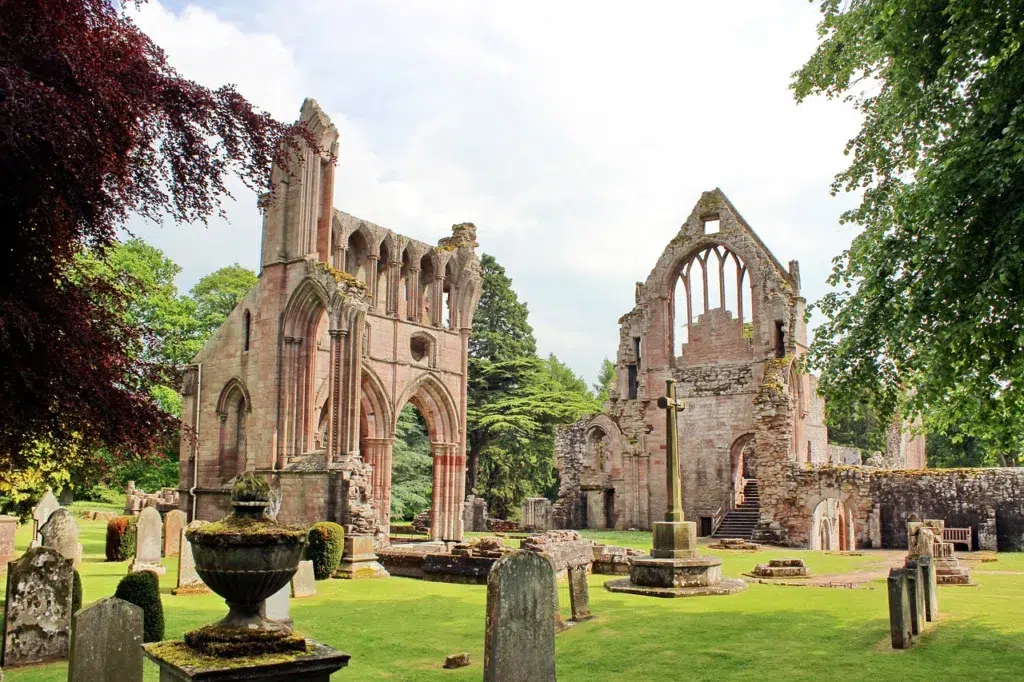
Dryburgh Abbey, Scottish Borders
You can walk through the Abbey and grounds finding information about what each area used to be. Also, you can find the resting place of Sir Walter Scott.
I recommend climbing around the different levels of the Abbey or walking through the old garden centre.
Moreover, a sunset is worth seeing at Dryburgh Abbey. Entrance to this Abbey is £3.50 and Historic Environment Scotland is currently caring for the Abbey.
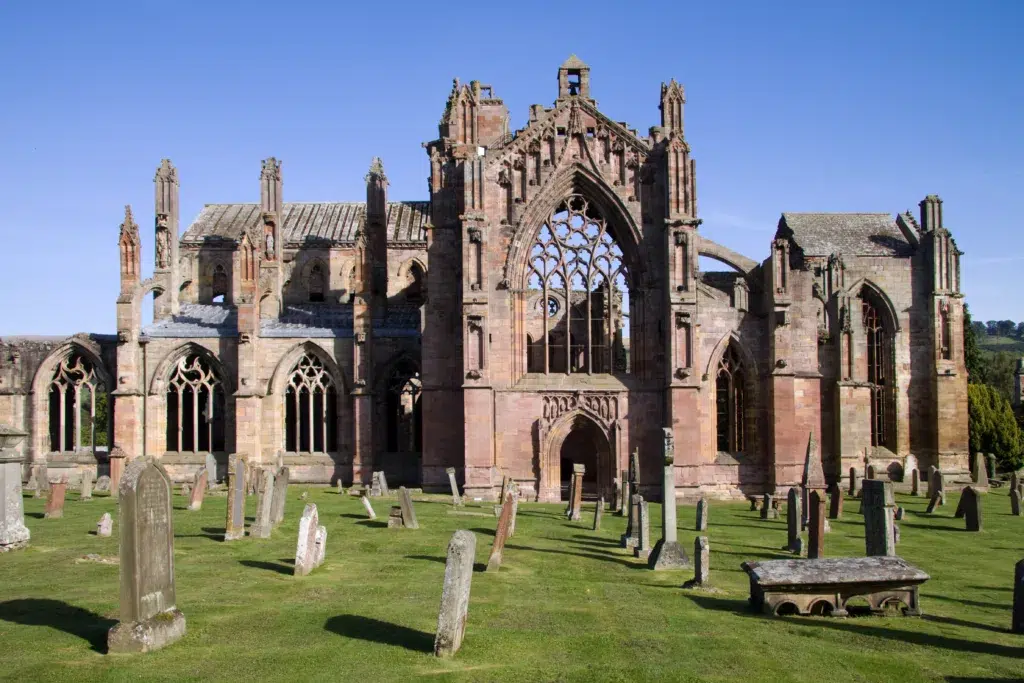
Melrose Abbey, Scottish Borders
One of the well-known Abbeys in Scotland, a partially ruined monastery is located in the Scottish Borders.
King David I of Scotland requested the building to be built in 1136. Nearly sixty years later it was nearly complete.
Many Scottish kings are buried at the Abbey, it is believed that Alexander II, with close links with Robert the Bruce, is buried here. Also, the Abbey is part of the Scottish Abbey’s Way walk alongside five other Abbeys.
The walls of this Abbey are still intact. Also, there are stairs to climb to get to the top of the tower.
Moreover, there is a graveyard to explore, all together, it makes Melrose a real gem to walk through.
The Melrose Abbey is currently managed by Historic Environment Scotland. For Historic Scotland members entrance to the Abbey is free.
Make sure to visit the website for discounts and up-to-date prices. Melrose Abbey is located on the Borders Historic Route.
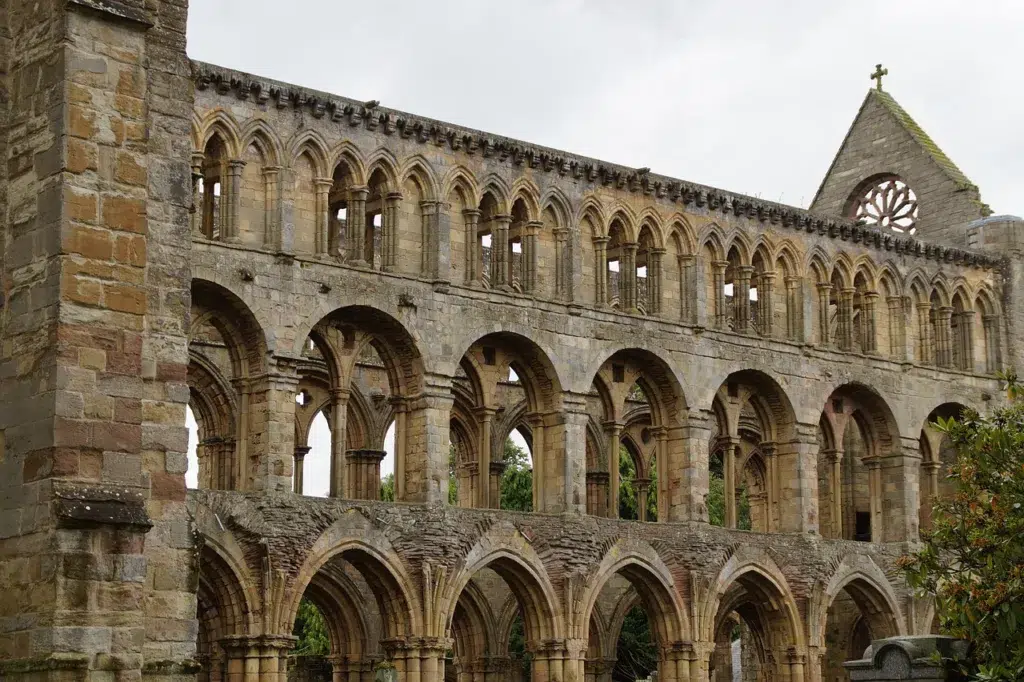
Jedburgh Abbey, Scottish Borders
Set on the hillside in the town of Jedburgh is Jedburgh Abbey. Centuries ago, English invaders would also attack this Abbey.
Due to the location only being ten miles away from the English border, it was an easy target. The Abbey was built in an early Gothic and Romanesque Style, now it is mostly a ruin.
Until the 19th century, worshippers would use the abbey, and restorations to the Abbey were abandoned in 1917. Now, the Abbey has been preserved and visitors can explore a visitor’s centre, a nearby stone display and a herb garden.
Recently, they have found more ruins underground. Make sure to walk up the tower and get a view down on the main hall of the Abbey.
Jedburgh Abbey is currently cared for by Historic Scotland and entry coasts £3.50 per adult.
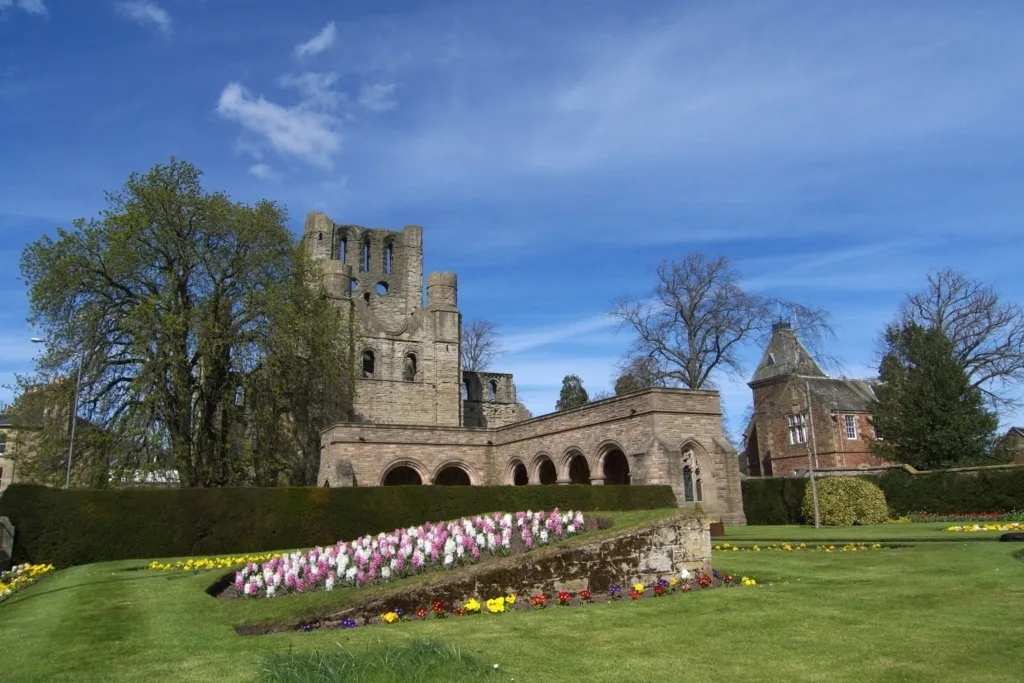
Kelso Abbey, Scottish Borders
Located in the small cute town of Kelso. The Abbey was founded by Tironesnsian Monks in the 12th century Kelso Abbey is a ruined monument with traditional Roman architecture.
The towers in the Abbey were similar to those found in Glasgow Cathedral. Multiple times the abbey was under attack by the English.
Damage was sustained from these attacks however, the ruins are still lovely to admire. Kelso Abbey is also managed by Historic Scotland and is free to visit.
Kelso is one of the small villages in the Scottish Borders.
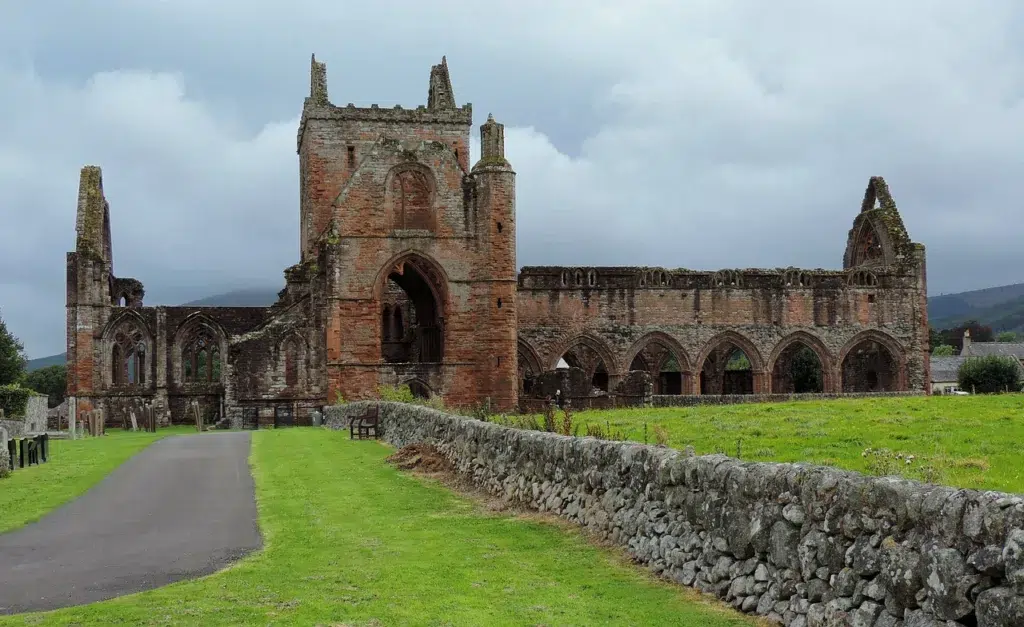
Sweetheart Abbey, Dumfries & Galloway
Standing tall and proud in a rural village in Dumfries is the gorgeous Sweetheart Abbey. The Abbey got its name as it was a tribute from a woman to her beloved husband.
When her husband passed away, she kept his embalmed heart, carrying it everywhere with her in an ivory casket. Later, she decided to name the Abbey after him.
Look out for her stone effigy, as well as the high altar where she was buried. Also, it is said that she was laid to rest holding her husband’s embalmed heart to her chest.
The Abbey was named Dulce Cor which translates to Sweet Heart. Sweetheart Abbey was founded by Dervorguilla of Galloway in the 1220s.
For over 700 years, the gorgeous abbey welcomed visitors every year to the grand ruins. Compared to the other destinations on this list, this Abbey will feel a lot less touristy when you visit.
The views from the graveyard are the best and you can walk around the graveyard for free. If you want to enter the ruins of the Abbey you will have to pay a fee.
Sweetheart Abbey is located on the long-distance route called South West Coastal 300. It is near Dumfries, a small town in Dumfries and Galloway.
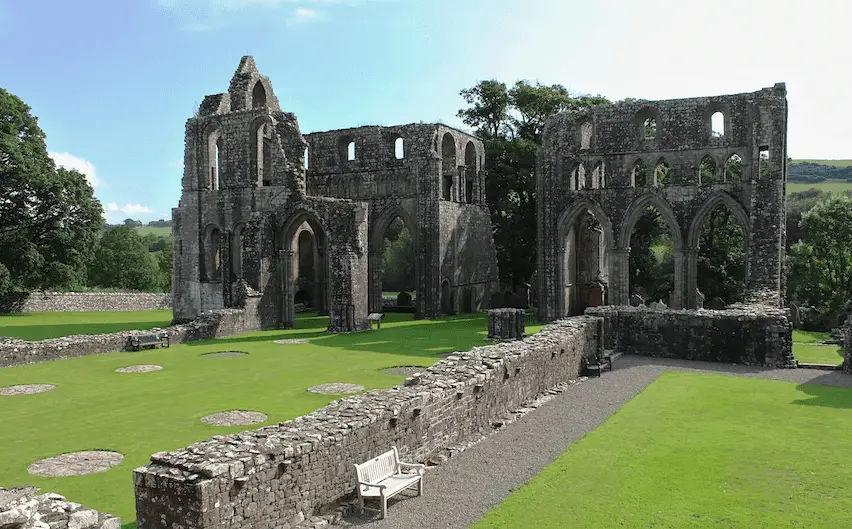
Dundrennan Abbey, Dumfries & Galloway
Under the order of King David I, Dundrennan Abbey was built in the 12th century. Located in the secluded village of Kirkcudbright in Dumfries.
This is one of the lesser-known abbeys in Scotland but it is still as spectacular as the others on this list.
Even though the structure is very much a ruin, many embellishments and features are still available to see.
It is good fun walking through the archways of the remaining walls. The gothic-style buildings are where Mary Queen of Scots spent her last final moments.
Historic Environment Scotland care manages Dundrennan Abbey and ticket prices start from £3.60.
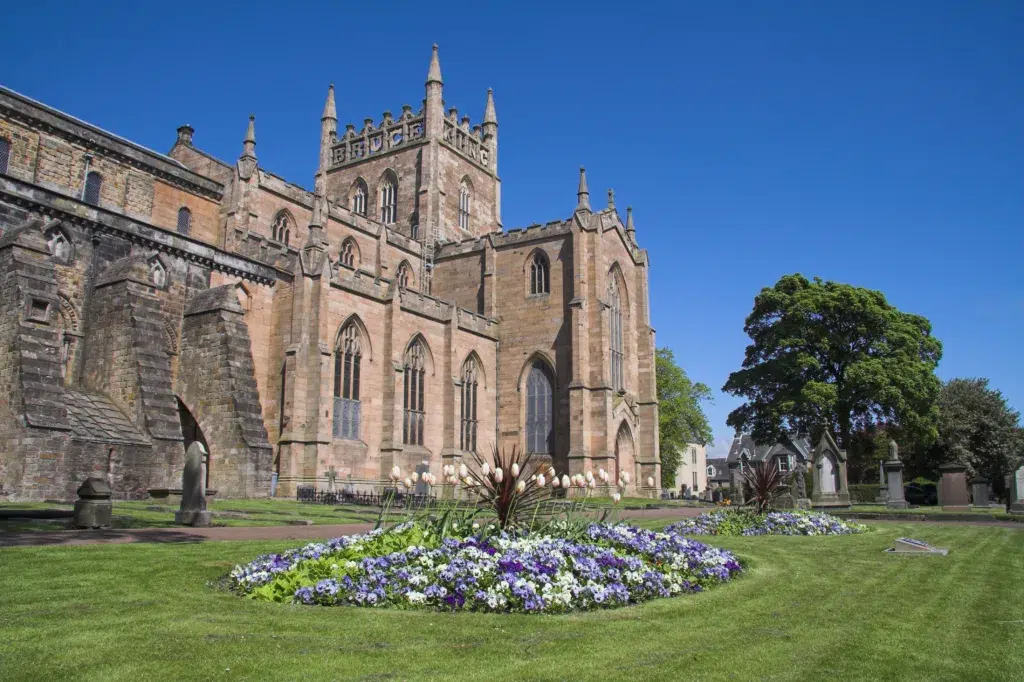
Dunfermline Abbey, Fife
Since 1072 this Abbey has been a worshipping place for adults. Located in Fife, near the Forth Bridges, it is a significant place in Dunfermline.
Many significant historical figures are resting here. Alexander I, King David I and Robert the Bruce have been buried here.
During the Protestant Reformation, a palace was constructed around the Abbey. The Abbey was made a royal mausoleum after its construction.
Interestingly, the last monarch of Scotland, Charles I, was born here. There are many similarities between the construction of Dunfermline Abbey and Durham Cathedral.
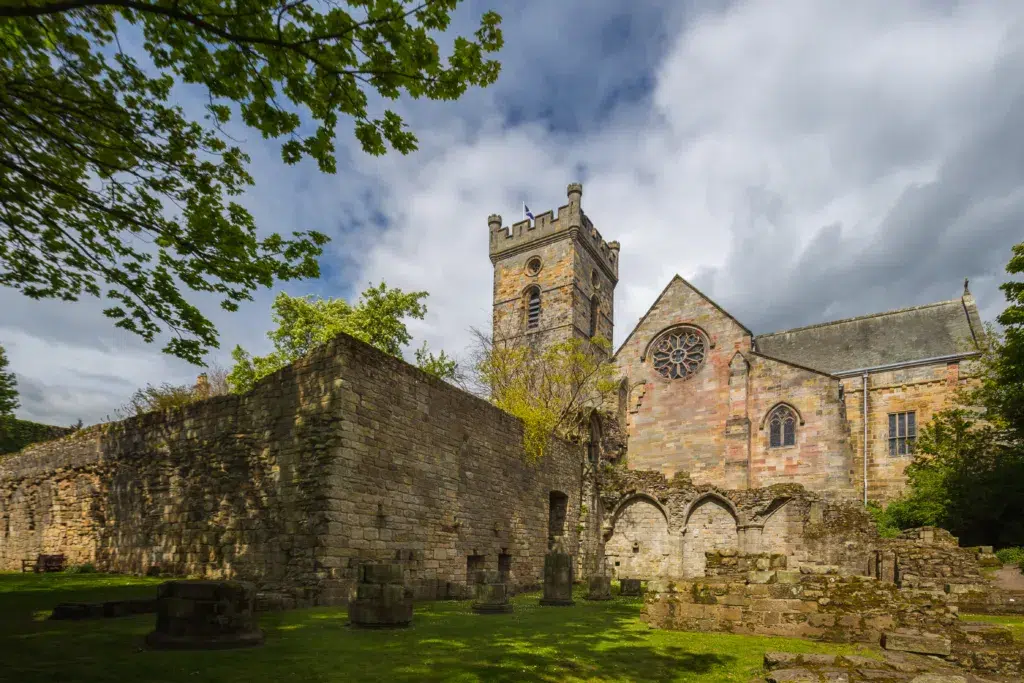
Culross Abbey, Fife
Located outside Edinburgh across the Firth of Forth in Culross, Fife. Culross is an unique and epic village in Fife.
Culross Abbey was founded in 1217 and is one of the few abbeys which is still partly in use. Currently, the Abbey is being partly used as a parish church.
The Abbey is a popular venue for weddings thanks to its beautiful surroundings and landscape. Most of the building was left to ruin, and only a small section has been renovated in the early 1900s.
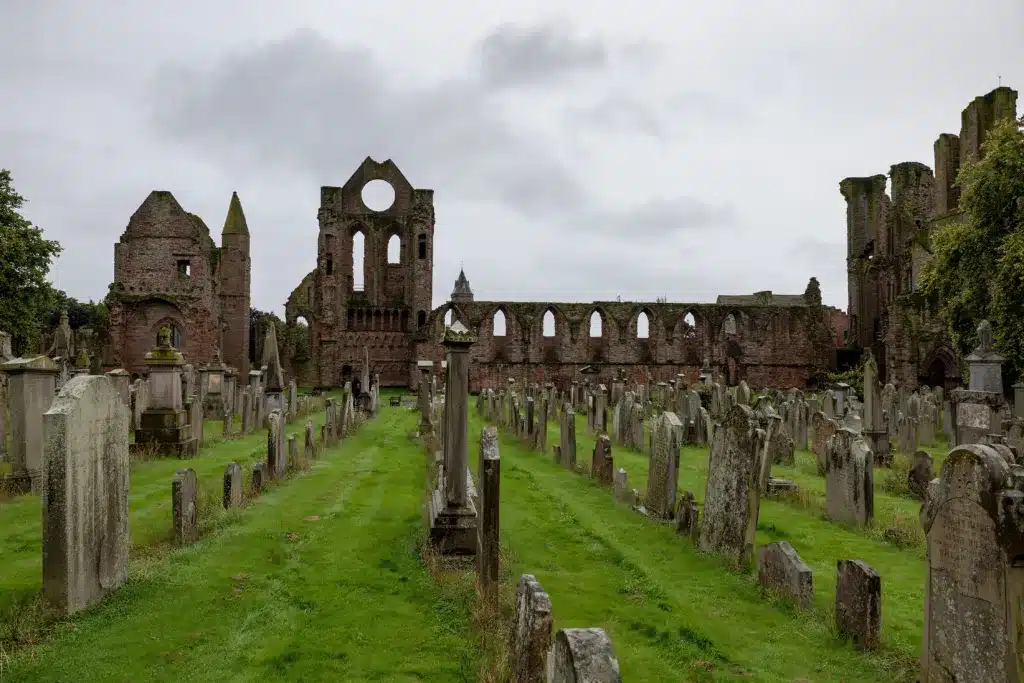
Arbroath Abbey, Angus
In 1197, Arbroath Abbey was built and is located in the coastal Angus town of Arbroath. The building is dedicated to Saint Thomas Becket.
Now the building is very much a ruin. A major historical event occurred at this abbey.
In 1320, Scotland swore its independence from England in a letter written and signed in Arbroath Abbey.
Back centuries ago, the building was a thriving part of the community and it was a gorgeous structure with red-coloured sandstones.
As it began to fall out of use, the stones were often stolen from the area to build homes in the nearby towns. Also, Arbroath Abbey is the location where the ‘Stone of Scone’ was brought after it was stolen in 1950 from Westminster Abbey.
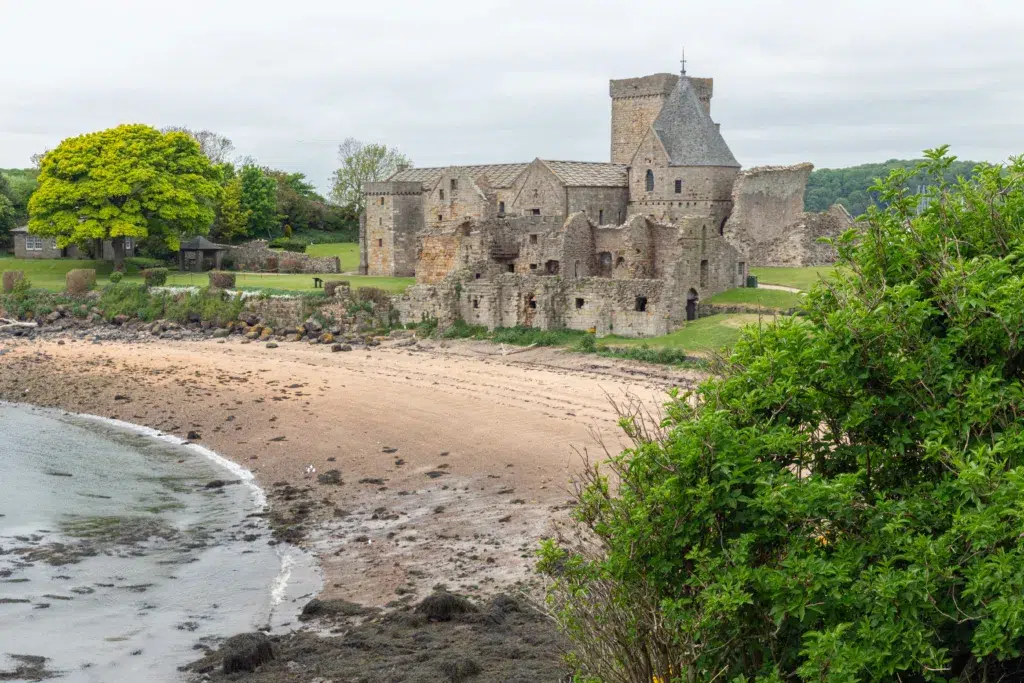
Incholm Abbey, Firth of Forth
In the Firth of Forth, located on the Isle of Incholm you will find the gorgeous Incholm Abbey. This Abbey was built in 1140 and is one of the best-preserved ruined Abbeys in the country.
Alexander I had sheltered on the island during a storm and found it a charming palace. To get to the abbey you will need to get a ferry.
Not only is the island surrounded by stunning scenery, but it is also packed with an interesting history as the island was used as a coastal defence base in both world wars.

Iona Abbey & Nunnery, Western Isles
Located on the Isle of Iona in the western isles of Scotland. The Isle of Iona is known as the ‘Holy Isle’ and is one of the oldest centres of the Christian faith in Western Europe.
Moreover, Iona is considered to be one of the centres that helped spread Christianity through Scotland in the early centuries. To get to the Isle of Iona you have to get a ferry to the Isle of Mull.
No cars are allowed on the Isle of Iona and the island is great for walking. It is expected that all visitors treat the sacred and holy island with respect.
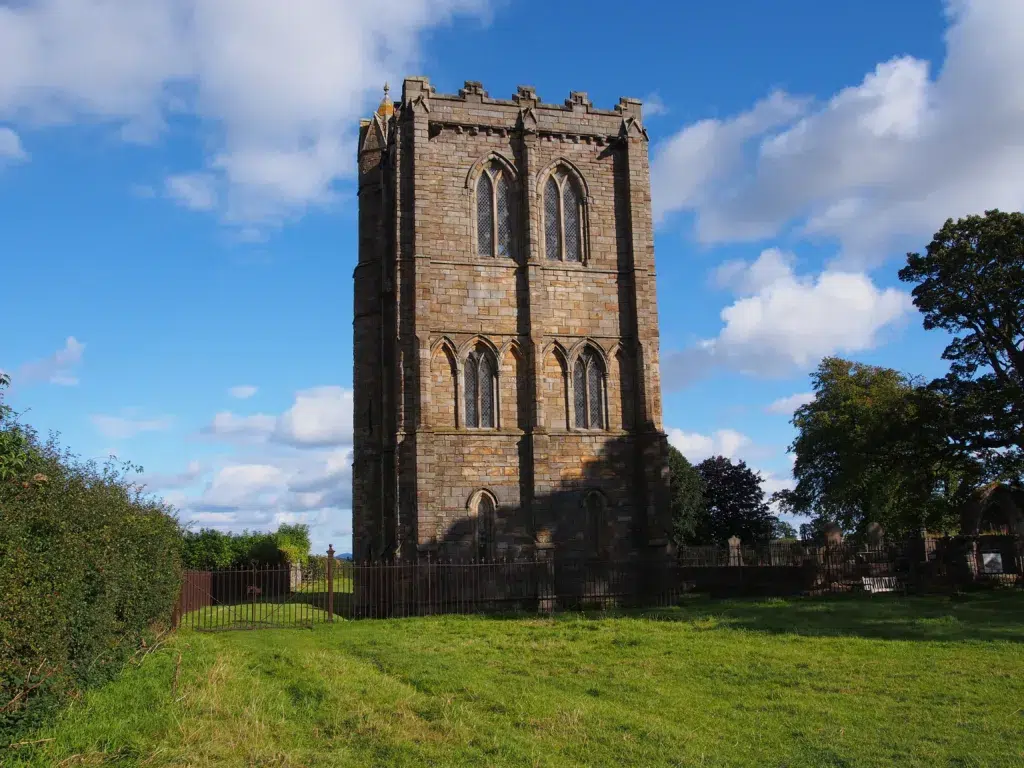
Cambuskenneth Abbey, Stirling
Located just a short walk away from the centre of Stirling. Remains of the bell tower of Cambuskenneth Abbey are still standing tall.
The abbey was founded in 1147, and the Gothic bell tower was well preserved in the 1860s, the vaulted ground floor and three storeys are all still intact.
The bell tower is a delight, and there are no parallels for this structure in Scotland. It is an excellent example of 13th-century architecture, with good lancet windows and ornamental arcades.
There are a few information boards with a bit of history about the structure. Also, there are some old graves in the grounds.
Cambuskenneth was the first parliament in Scotland. At the time noblemen and clergy swore an oath of faith to David Bruce, the heir to the throne.
Robert the Bruce’s parliaments were here in 1314 and 1326. James III and Margaret of Denmark are buried here in the 1480s.
Pluscarrden Abbey, Moray
Now heading up to Moray you will find a Catholic Abbey. Built back in the 13th century and visitors have been welcome since.
People from all walks of life are welcome to reflect in the calm and quiet of the glen in which the abbey sits. This is one of the very few Abbeys which are still being used for their original purpose.
A community of Benedictine monks still live and work in the Abbey, advocating values of serenity, reflection and work. Entrance to the Abbey is free.
Crossaguel Abbey, Ayrshire
On the west coast near Ayr, you can find the ruins of Crossaguel Abbey. When the Abbey was first built in 1244, the abbey was a simple chapel for the Benedictine monks from Paisley Abbey in Glasgow.
Over the years it began to expand before being left abandoned, leaving only ruins now. Now all that remains is the pigeon tower, cloister and original chapel which the monks first built.
There are information boards and plaques detailing the history of the building. The site is now managed by Historic Scotland and is currently closed.
Kilwinning Abbey, Ayrshire
In a small town in North Ayrshire in the centre of Kilwinning, you will find Kilwinning Abbey.
The 12th-century structure stands tall on Main Street. Compared to other ruins on this list, it is quite small and there is little to explore, but still, it is very impressive.
For over 400 years, this Abbey was the peaceful home of Tironensian monks. Following the Scottish Reformation in 1560, the Abbey fell into ruin. There is a clock tower which was refurbished in 1816 and stands 100ft tall.
Kilwinning is a small village in Ayrshire and is located on The Coig Route.
Glenluce Abbey, Dumfries & Galloway
Cistercian monks constructed this Abbey in 1190 and the building has been well-preserved over the centuries. Located near the Water of Luce the ancient monument fell into disuse following the Scottish Reformation.
Over the past few centuries, there have been effects to restore and refurbish it, however, all attempts have failed. This ancient Abbey is a truly amazing and tranquil space.
Some parts are really intact, it is fascinating to walk around and imagine what life must have been like for the monks. Historic Scotland currently owns the site and it is now closed for the time being.
Balmerino Abbey, Fife
Overlooking the River Tay you will find the remains of the 13th century Cistercian monastery.
In 1229, Balmerino Abbey was founded by Queen Ermengarde, widow of William the Lion, mother of Alexander II. She was buried in the site of the Abbey in 1233.
One of the oldest trees in Fife is found on the Abbey’s grounds. It is rumoured that the Spanish chestnut has been planted by Queen Ermengarde and it is 400 years old.
A historical spot for the community, it is a nice place to have a wander or relax with a picnic.
Restenneth Priory, Angus
Restenneth Priory is located in Forfar, Angus and dates back to the 12th century. Alexander I had the annals of Iona transferred to the priory in the 1100s and Robert the Bruce had his son buried here in the 14th century.
There is very little left standing except for a few foundations, the chapter house and a vaulted cellar. Restenneth Priory is free to visit and is open all year round, you can view the exterior only.
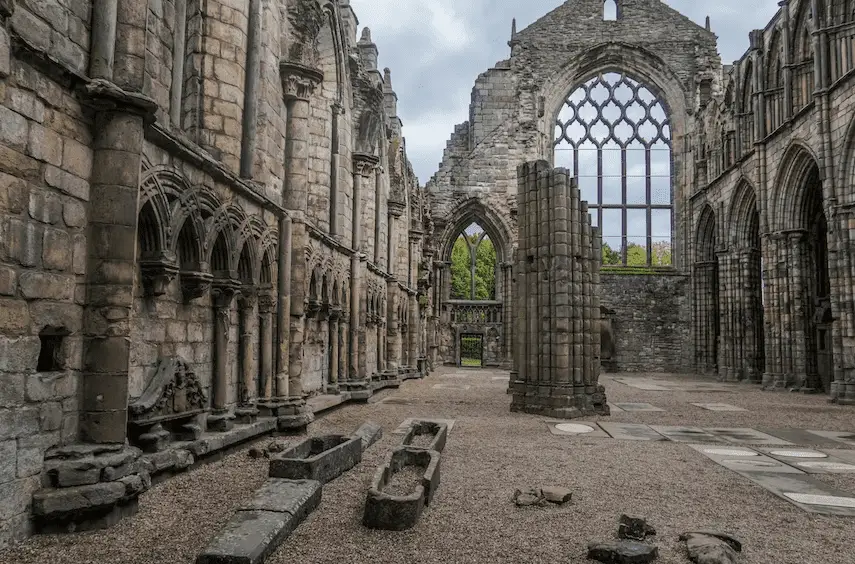
Holyrood Abbey, Edinburgh
Holyrood Abbey marks the beginning to the famous Royal Mile. It was founded by King David I, first built in 1128 as an Augustinian abbey.
The Abbey is very atmospheric, imposing and yet remarkably well-maintained ruin. There are intricate stonework, memorials and burial sites.
Also, there is a complimentary audio guide that has all sorts of detailed information.
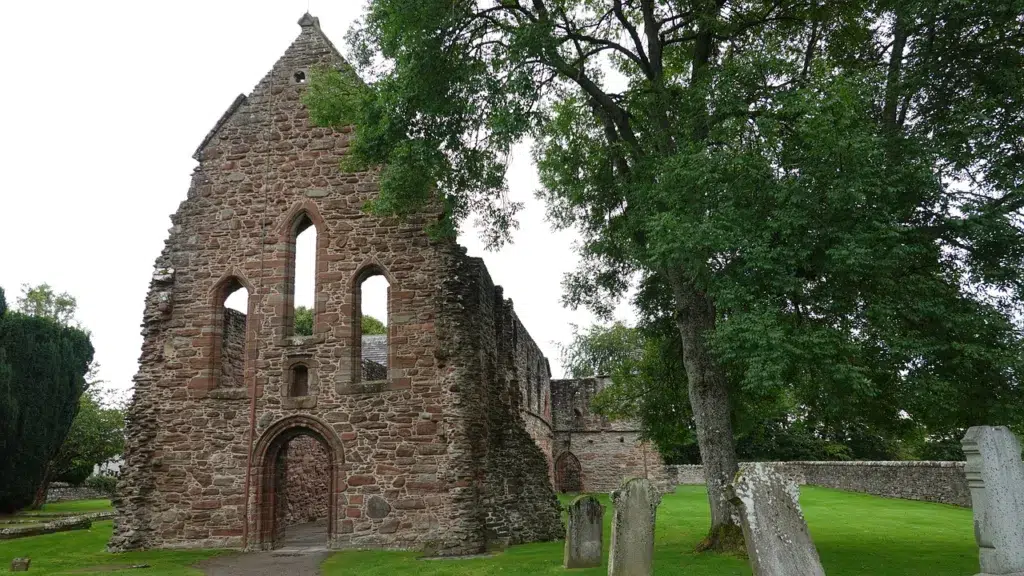
Beauly Priory, Inverness
Hidden away in Beauly, near Inverness is the quiet and unassuming Beauly Priory. There are information signs dotted around the abbey to show the history of the priory.
It is well worth the visit and a great example of Scottish medieval architecture. Beauly means “Beautiful Place”, and the monks must have thought that this was a beautiful place to devote themselves to worship. Entry is free.
Beauly Priory is a detour on the North Coast 500 route.
What Abbeys are in Scotland?
There are a few Abbeys near the border between Scotland and England. Kelso, Melrose, Dryburgh and Jedburgh are the most well-known Abbeys in Scotland. These four Abbeys are located in the Scottish Borders.
Less known but equally as gorgeous is Sweetheart Abbey which is located in Dumfries and Galloway. Dundrennan Abbey is also a quiet abbey you must visit and you can have the place to yourself.
Further north in Edinburgh, Fife and Angus you fill find Holyrood Abbey, Incholm Abbey, Dunfermline Abbey, Culross Abbey, Balermino Abbey and Arbroath Abbey.
There is also Abbeys in the Western Isles, Ayrshire, Stirling and Moray. All together there is over 20 Abbeys and historical sites in Scotland.
Why are there so many abbeys in the Scottish Borders?
It is believed that many Abbeys were built in the Scottish Borders to impress visitors from England. The Abbeys were to show that the Scots were capable of fine-building projects.
Final Note
The Abbeys in Scotland only represent a tiny fraction of Scotland’s dramatic history and culture. You will be wanting to visit as much of Scotland as possible after catching the smallest glimpse of what Scotland has to offer.
